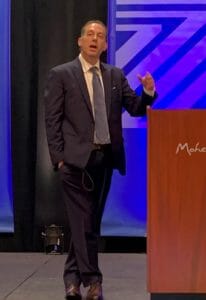
UNCASVILLE, CT — Providers basking in what appeared to be a major bright spot of the 2022 SNF PPS final pay rule still have plenty to be worried about, one of the industry’s leading payment experts warned Wednesday.
Nursing homes could be headed for Medicare Part A payment cuts of 10% or more late next year after federal regulators removed a potential 5% cut from consideration this year, said Marc Zimmet, president of Zimmet Healthcare Services Group at its annual conference on Wednesday.
By “kicking the can down the road,” federal regulators may simply use the time to find more reasons to cut reimbursement levels in the nascent Patient Drive Payment Model.
“My issue is with [PDPM’s] budget-parity adjustment,” Zimmet told 1,100 attendees in a Mohegan Sun resort exhibit hall. “They want $1.7 billion. If we don’t do something about this now, we won’t be facing a 5% recalibration. We’ll face a 10% to 12% reduction.”
He said faulty assumptions and calculations by the Centers for Medicare & Medicaid Services, coupled with a “pretty weak” nursing home industry response, has put providers at risk.
PDPM debuted Oct. 1, 2019, as the biggest overhaul to nursing home payments in a generation. Well before the public health emergency was declared in March 2020, many experts said the new rates appeared to be more generous than CMS’s budget-neutral plan had called for.
Because of pandemic upheaval, no adjustments were made last year to PDPM rates. CMS, however, set stakeholders abuzz in April when it issued its 2022 proposed SNF PPS pay rule, claiming that PDPM payments were 5%, or about $1.7 billion, above expectations. Nursing home associations and other advocates swamped CMS with formal comments that the payment calculations were overblown and urged the agency to leave rates unchanged until further study could be undertaken.
‘Lacks integrity’
That is ultimately what the agency did when it issued its final rule the last week of July and announced it would not be adjusting PDPM rates this cycle.
“There is so much wrong about using the average per diem rate,” Zimmet explained of CMS’ methodology. “Even without prospective COVID distortion, using this methodology in a post-pandemic world lacks comparative integrity and could leave SNFs a larger recalibration next year.”
He called seven aspects of the way CMS calculated spending rates wrong, among them not compensating SNFs for any COVID-19 care or related costs until April 1, 2020, and then assuming that all facilities were affected the same. He also said patients returning from the hospital were wrongly reimbursed at the same rate as under the previous RUG-IV system and therapy usage rates were incorrectly projected.
Zimmet also listed nine mitigating factors where CMS miscalculated or misattributed $1.35 billion in spent funds — nearly all of what the government said exceeded its original expectations when other factors are added in. The largest portion of that was $400 million for hospital transitional care units and transfers, which Zimmet says cost far more than freestanding SNFs would have for the same services.
“The hospitals took our money,” he said. “This one drives me crazy.”
Strong pushback sought
While at one point praising national nursing home associations for “doing a good job,” Zimmet also criticized them for allegedly not doing enough to “address the underlying causation” of PDPM problems.
“By legitimizing CMS’s proposal, skilled nursing is mortgaging its future as dollars shift to other healthcare sectors,” he warned.
There shouldn’t be any future clawback at all, he later told McKnight’s Long-Term Care News.
“Objections have to come from the national level,” he said. “They [CMS] aren’t going to listen to us if we don’t say anything.”
Skilled nursing providers have never faced a more challenging time, Zimmet feels. Accountable care organizations and other value-based purchasing options are forcing shorter lengths of stay with sicker patients, while healthcare systems are retaining the savings at SNFs’ expense.
While shorter lengths of stay result in higher reimbursement rates in the short term, they are for shorter durations — and at rates that skilled nursing stakeholders suspect will get winched down in future budgeting. Particularly at risk are rates for nursing, non-therapy ancillaries and speech language pathology services, which providers have become more adept at, ironically putting them at greatest risk for trims, observers agreed Wednesday.
“If we face a 5% recalibration, and hospitals and ACOs take us down as well, we’re in trouble,” Zimmet said. “If we let this per diem rate methodology come to fruition without offsetting all those factors, then we’re in trouble.”
Ultimately, CMS must reconsider PDPM’s goal of budget neutrality, he said, noting that it was designed to pay truer costs of a wider range of care, and be a more sophisticated system for a sicker population.
“My question for CMS is: If PDPM is supposed to be budget neutral, and if aggregate spending is supposed to be the same as it spent under the RUGs system, then what’s the point if it’s not going to pay what it said it would pay for?”




